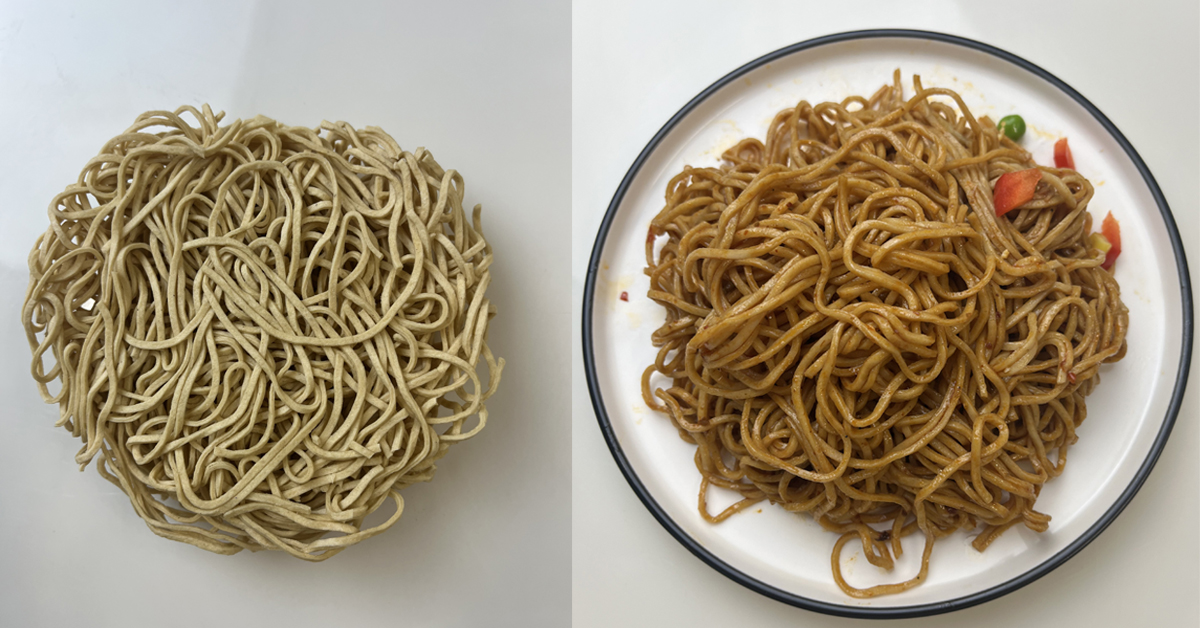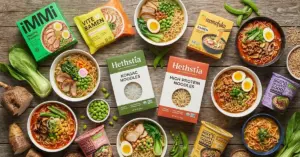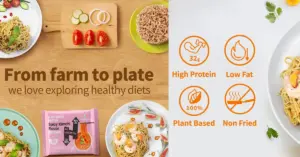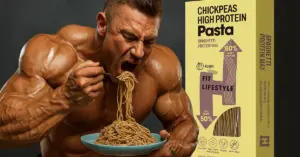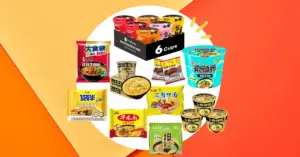Many people pick high-protein noodles for many reasons. You might like them if you play sports, want to lose weight, eat low-carb or keto, eat plant-based, need gluten-free food, or cook for your family.
- People often choose these noodles to build muscle, control blood sugar, or feel full longer.
- High Protein Instant Ramen and other choices are good for people who want fast, healthy meals.
You can find noodles made from beans, peas, or even cricket protein. Each kind gives you different benefits.
Key Takeaways
- High-protein pasta help your muscles grow. They help control blood sugar. They keep you full for a longer time. This makes them good for athletes and active people.
- Plant-based, high-protein noodles are made from beans, lentils, or chickpeas. They provide high-quality protein for vegetarians and vegans, and are also suitable for people who don't eat meat.
- Low-carb and keto dieters can eat high-protein pasta with fewer carbs. These noodles help with weight loss. They also help stop cravings.
- Gluten-free high-protein pasta use legumes. They are healthy and safe for people with gluten intolerance. They are also safe for people with celiac disease.
- Busy people and families can make quick meals with high-protein noodles. These noodles are easy to cook. They are also good for kids.
High-Protein Noodles for Fitness and Muscle

Athletes and Gym-Goers
If you regularly exercise or hit the gym, you know how crucial protein is for muscle development. High-protein pasta can help you meet your daily protein requirements.
Most athletes need approximately 1.6 to 2.7 grams of protein per kilogram of body weight daily. After workouts, you should replenish protein to aid muscle recovery and growth. For optimal results, you can also pair these noodles with carbohydrates.
Tip: Eating protein and carbs together after exercise helps your muscles recover faster and boosts your performance the next day.
Here are some science-backed benefits of eating high-protein noodles after exercise:
- Combining protein and carbohydrates aids muscle recovery and energy storage.
- Consuming both simultaneously reduces fatigue and helps you perform better in your next workout.
- The optimal ratio is 3 to 4 servings of carbohydrates to 1 serving of protein.
- Whey protein and beef protein work best, but plant-based noodles are a good alternative if you avoid meat.
- Consuming protein immediately after exercise supports muscle repair and growth.
Some people worry that consuming too much protein may damage their kidneys or bones. Research shows that healthy individuals can consume more protein without harming their kidneys or bones. A high-protein diet may even help strengthen bones and promote muscle growth.
Muscle Building for Non-Meat Eaters
You do not have to eat meat to build muscle. Plant-based high-protein noodles can provide the protein you need. Many brands use soybeans, lentils, chickpeas, or quinoa to make these noodles. These foods are rich in protein and easy to incorporate into your meals.
Here is a table showing common plant-based protein sources used in high-protein pasta:
| Plant-Based Protein Source | Protein Content (per serving) | How It’s Used in Noodles |
| Tempeh | 34 grams | Fermented soy, meat substitute |
| Tofu | 20-22 grams | Soy protein, added to noodles |
| Edamame | 18 grams | Young soybeans, protein boost |
| Lentils | 18 grams | Lentil-based noodles |
| Chickpeas | 15-18 grams | Chickpea pasta, added to dishes |
| Quinoa | 8 grams | Grain-based noodles |
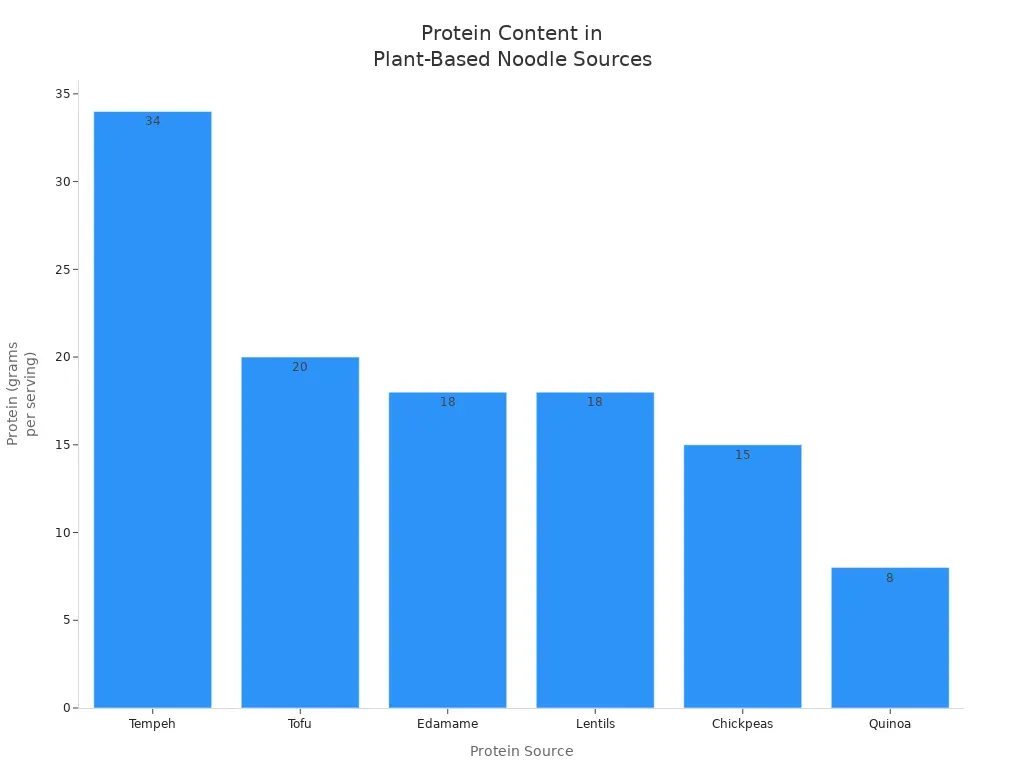
High-Protein Noodles for Weight Loss and Low-Carb Diets
ketogenic dieters and low-carb dieters
If you follow a keto or low-carb diet, you look for foods with fewer carbs and more protein. High-protein noodles can help you meet your goals. Many brands offer noodles with much less carbohydrate than regular pasta.
For example, Hethstia high-protein chicken noodles have only 21 grams of net carbs and 32 grams of protein per serving. This is much lower than traditional noodles, which often have over 30 grams of net carbs and less protein.
Product Name | Protein (g) | Net Carbs (g) |
32 | 21 | |
14 | 32 | |
24 | 20 | |
Miracle Noodle Pasta (Shirataki) | 0-1 | 1 |
Regular pasta typically contains about 7 grams of protein and 38 grams of net carbs per serving. High-protein pasta usually contains 10 to 32 grams of protein and 15 to 21 grams of net carbs. You can see the difference in the table below:
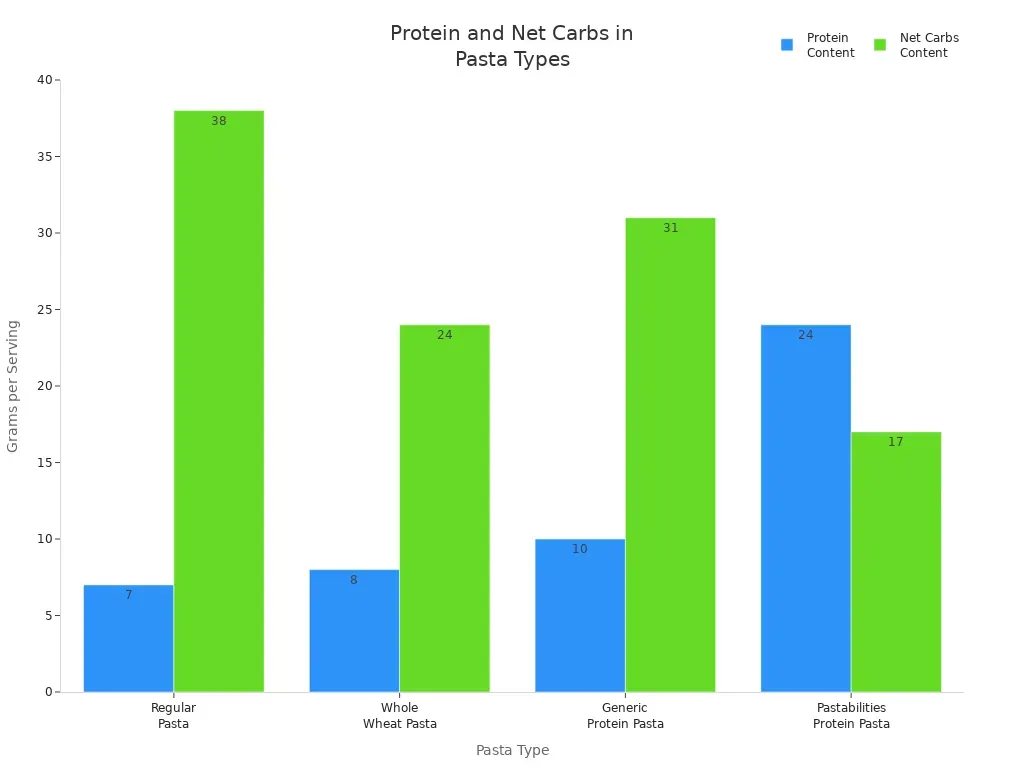
Choosing noodles with more protein and fewer carbs helps you stay in ketosis and control your blood sugar. You can enjoy noodle dishes without worrying about breaking your diet.
Satiety and Reduce Cravings
You may notice that you feel hungry soon after eating regular noodles. High-protein noodles can help you feel full longer. A study found that people who ate a high-protein noodle breakfast ate about 10% fewer calories at lunch than those who ate regular noodles. The high protein content helps you stay satisfied and reduces cravings for snacks.
Tip: Eating more protein at breakfast or lunch can help you avoid overeating later in the day.
Researchers also found that pasta does not cause weight gain when you include it in a low-glycemic diet. Pasta has a lower glycemic response than rice, potatoes, or bread. This means your blood sugar rises less, and you feel less hungry after eating. You can use high-protein noodles to help manage your weight and control your appetite.
- Studies show that pasta intake is not linked to weight gain.
- Pasta in low-glycemic diets may support weight loss.
- Pasta causes less hunger than other starchy foods.
- More research is needed, but high-protein pasta look promising for weight management.
You can choose high-protein noodles to help you feel full, eat fewer calories, and support your weight loss journey.
High-Protein Noodles for Plant-Based and Gluten-Free Diets
ketogenic dieters and low-carb dieters
If you are vegetarian or vegan, you can enjoy high-protein noodles. Many brands use plants to increase the protein content of their noodles. These noodles can help you get enough protein without consuming animal products. They also contain more fiber than regular noodles. This helps you feel full and avoid overeating.
Dietitians say vegetarians and vegans need more protein from plants. Noodles made from beans and lentils give you all the amino acids you need. This helps you build muscle and stay healthy.
Here are some foods that add protein to vegan noodle meals:
Protein Source | Description & Use in Noodles | Protein Content (approx.) | Notes on Suitability for Vegetarians/Vegans |
Soy Products | Includes tofu, tempeh, edamame; used in various vegan noodle dishes | 8-11 grams per 85g serving | Complete protein, widely used in vegan cooking |
Buckwheat | Used in Japanese soba noodles | ~6 grams per cup cooked | Pseudocereal, complete protein, common in vegetarian/vegan noodles |
Quinoa & Amaranth | Pseudocereals sometimes incorporated into noodles or flours | High protein (varies) | Complete proteins, plant-based |
Hemp Seeds & Chia Seeds | Seeds sometimes added for protein enrichment | Varies | Plant-based, good protein sources |
Peanuts & Peanut Butter | Used in dishes like peanut & herb noodle salad | ~25.8g per 100g peanuts; ~3g per tbsp peanut butter | Good plant protein, often combined with noodles |
Tip: Add peanut butter or tofu to your noodles for more protein and taste.
Gluten-Free Options
Some people need gluten-free noodles because of celiac disease or gluten problems. High-protein pasta made from chickpeas, lentils, and edamame are safe and healthy. These noodles use legume flours and blends to make them taste better and add protein.
Here are some popular gluten-free, high-protein noodle brands:
Brand/Type | Main Ingredients | Protein Highlights |
Hethstia High Protein Instant Ramen | Pea protein, Buckwheat flour, Pea fiber powder, Glutinous rice flour, Konjac powder | High protein (32g per serving), high fiber (5g) |
Banza Gluten-Free Bucatini | Chickpea flour, pea starch, tapioca starch | High protein (20g per serving), high fiber (8g) |
Bionaturae Gluten-Free Spaghetti | Lentil flour | High-protein alternative to traditional spaghetti |
Rummo Gluten-Free Penne Rigate No. 66 | Brown rice flour, yellow corn, white corn, rice, potato starch | Gluten-free blend with vegetable-derived ingredients |
Kaizen Fusilli or Radiatori | Lupini bean flour, fava bean protein, tapioca starch, xanthan gum | High protein content, legume-based pasta |
These noodles have more protein and fiber than most gluten-free pasta. Scientists say adding fiber, protein, and prebiotics makes gluten-free noodles healthier. These noodles are tested to be safe for people with celiac disease.
Note: Always check the label to make sure your noodles are gluten-free.
Choosing legume noodles is also good for the planet. Chickpea pasta uses less water and fewer chemicals than wheat pasta. Spelt noodles are better for the earth because spelt grows well in poor soil and needs fewer chemicals. These choices help the environment and your health.
High-Protein Noodles for Busy Lifestyles and Families
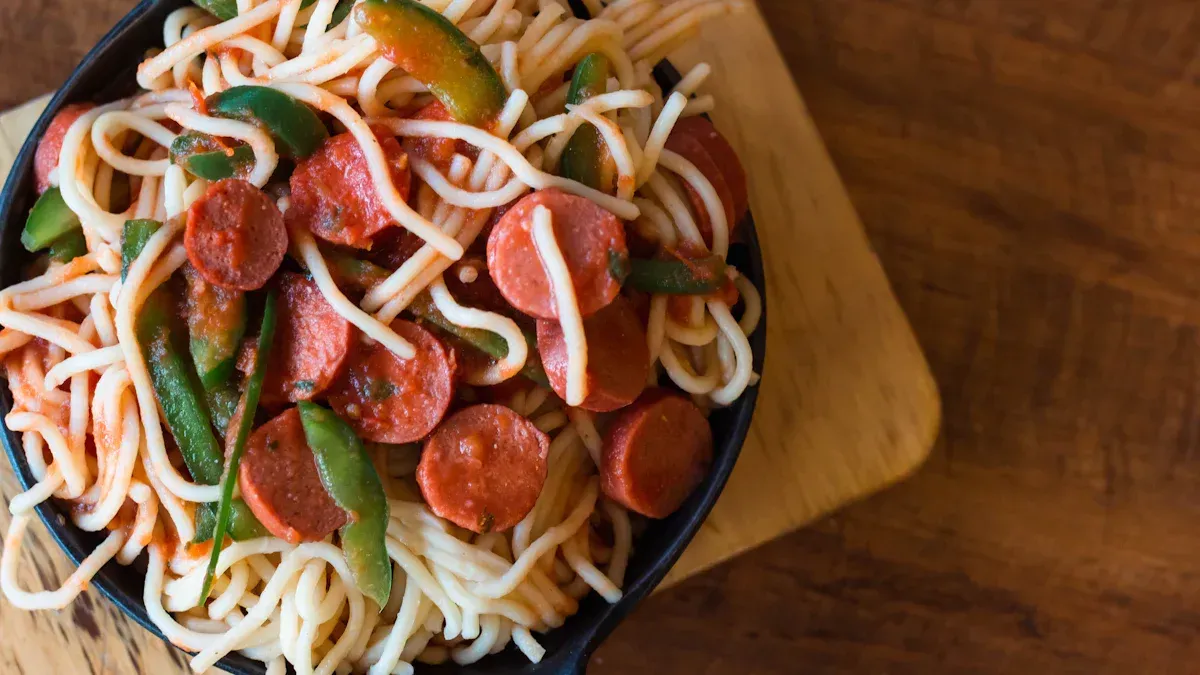
Quick, Nutritious Meals
Sometimes you are very busy during the week. High-protein pasta helps you make fast, healthy meals. You do not have to give up good nutrition. More people are buying these noodles because they want quick, healthy food.
In 2023, most protein noodle sales were from instant or fast-cooking types. Many high-protein pasta dishes take only 10 to 15 minutes to cook. For example, creamy sun-dried tomato pasta with chicken has 40 grams of protein and 7 grams of fiber in each serving. Lemon asparagus pasta with feta is ready in 10 minutes and gives you 20 grams of protein. These meals use protein and fiber to help you feel full and give you energy.
Tip: Try instant cup noodles for a fast meal. Just add hot water, stir, and you get a lunch with lots of protein.
Here are some Hethstia high-protein noodle products that are easy to make:
Product Name | Flavor/Type | Protein Content / Features | Convenience Aspect |
Chicken | Plant-based, 3x protein of ordinary noodles | Instant, cup form | |
Beef | 32g protein, low carbs | Packaged for quick meals | |
Pork Tonkotsu | High protein, 40% less sodium | Bulk and cup noodle options | |
Spicy Kimchi | Plant-based, high protein | Instant, suitable for on-the-go |
These noodles help you eat well even when you are busy.
Kid-Friendly Choices
You want your kids to eat healthy foods they like. High-protein pasta can make meals fun and good for them. Pick pasta made from whole foods like legumes or non-GMO wheat.
Stay away from noodles with extra sugar or strange things added. Serve noodles with sauces kids know, like marinara, or with roasted veggies or mild cheese. Fun shapes like dinosaurs or zoo animals make eating more exciting and help kids try new foods.
- Let your child pick their own toppings for noodles.
- Give smaller portions because kids need less protein.
- Use tastes and textures they already like so they will eat it.
Here are some high-protein noodle brands and flavors for families:
Kids like noodles that taste plain and are chewy. Shapes like ABC 123 Pasta and Dinosaur Pasta make meals more fun. You can make healthy meals by adding veggies and good sauces to high-protein noodles.
Choosing the Right High-Protein Pasta
Dietary Preferences
You need to think about your diet before picking high-protein noodles. Some noodles work better for certain diets.
For example, if you eat vegan or vegetarian, you can choose chickpea or lentil pasta. These noodles give you lots of protein and fiber. If you need gluten-free food, look for noodles made from beans, konjac, rice, or pure buckwheat.
People on low-carb diets often pick shirataki noodles. These noodles have almost no carbs but lots of fiber, which helps you feel full.
Tip: Always check the fiber and carb content. Even on vegan or keto diets, you can get enough fiber if you pick the right noodles.
Noodle Type | Protein (per 2 oz) | Fiber (per 2 oz) | Gluten-Free | Vegan/Vegetarian | Notes |
Chickpea Pasta | 12~30g | 8g | Yes | Yes | High protein and fiber |
Lentil Pasta | 14g | 6g | Yes | Yes | Very high protein |
Shirataki Noodles | ~0g | 3g | Yes | Yes | Very low carb, high fiber |
Soba Noodles | 7g | 3g | Yes* | Yes | Gluten-free if 100% buckwheat |
Rice Noodles | 3g | 2g | Yes | Yes | Lower protein, good for gluten-free |
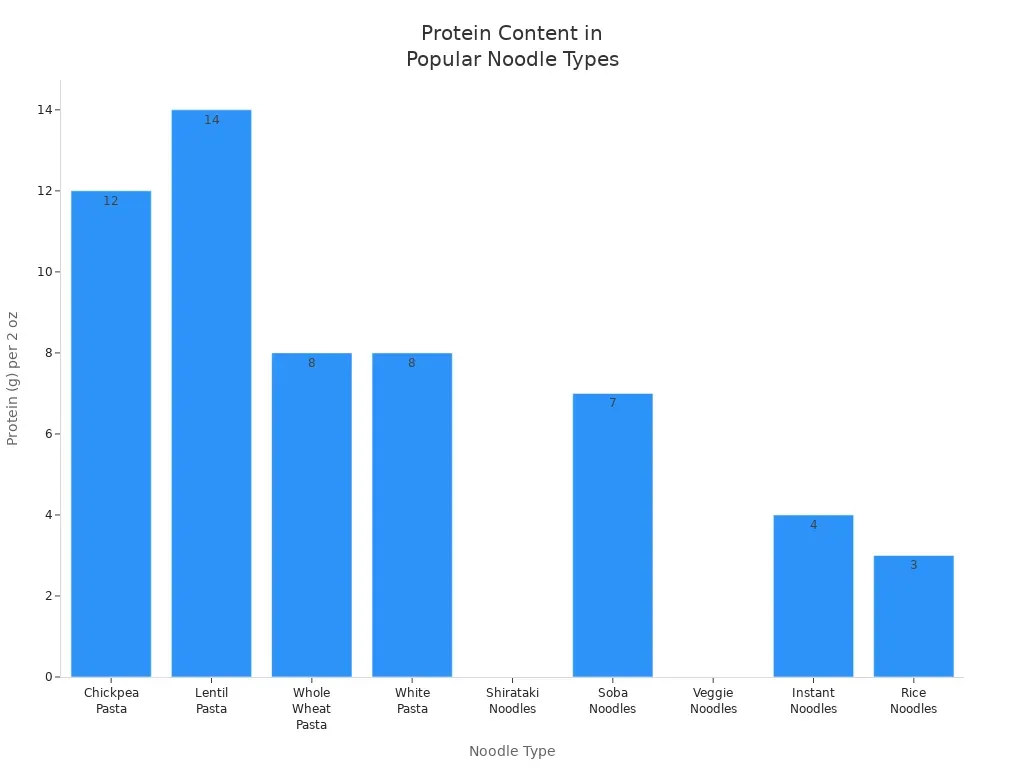
Nutrition Label Tips
You should always read the nutrition label before buying high-protein noodles. Start by checking the serving size. This helps you know how much protein and fiber you get in one portion.
Look at the calories to see if the noodles fit your energy needs. Check the protein and fiber content to make sure you get enough for your diet. Pay attention to sodium levels, especially in instant noodles, as they may contain high amounts of salt.
Note: Many high-protein noodles contain common allergens like wheat, eggs, soy, or sesame. Look for these in the ingredient list or in the “Contains” statement on the package.
Here are the most important things to check on the label:
- Serving size
- Calories per serving
- Protein and fiber content
- Sodium level
- % Daily Value for protein
Element | Why It Matters |
Serving Size | All nutrition info is based on this amount |
Calories | Helps you manage your daily energy intake |
Protein Content | Shows if the noodles meet your protein goals |
Fiber Content | Supports digestion and helps you feel full |
Sodium Content | Important for heart health, especially in instant noodles |
% Daily Value | Tells you how much of your daily needs you get |
You can use these tips to pick the best noodles for your health and lifestyle.
You can benefit from high-protein pasta if you want to manage your weight, build muscle, follow a low-carb diet, or eat more plant-based foods.
- Athletes, children, and health-conscious eaters find these noodles helpful for their goals.
- Some people face challenges like higher costs or limited choices, but new products appear every year.
Tip: Try different noodle types to see which fits your taste and lifestyle best.
Think about your own needs and goals before choosing. You may discover a new favorite that supports your health.
FAQ
Can you eat high-protein noodles every day?
You can eat high-protein noodles daily if you balance your meals. These noodles help you get more protein. You should also eat vegetables and other foods for a healthy diet.
Are high-protein pasta safe for kids?
High-protein pasta is safe for most kids. You should check the ingredients for allergens. Kids need less protein than adults. Serve smaller portions and add vegetables for extra nutrition.
Do high-protein noodles taste different from regular noodles?
Some high-protein noodles taste like beans or lentils. Others taste close to regular pasta. You can try different brands to find one you like. Sauces and toppings help improve the flavor.
Can you use high-protein pasta in any recipe?
You can use high-protein pasta in most recipes. They work well in soups, stir-fries, and pasta dishes. You may need to adjust cooking times. Always check the package instructions.
What is the best way to store high-protein noodles?
Store dry high-protein noodles in a cool, dry place. Keep them in a sealed container. Cooked noodles should go in the fridge and be eaten within three days.

